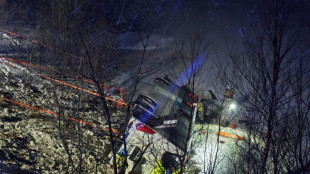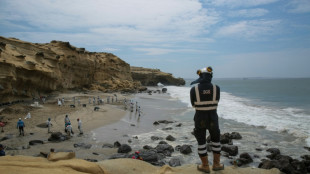
-
 Thunder NBA win streak at nine as Shai ties career high with 45
Thunder NBA win streak at nine as Shai ties career high with 45
-
India announces state funeral for ex-PM Manmohan Singh

-
 Japan govt approves record budget for ageing population, defence
Japan govt approves record budget for ageing population, defence
-
Japanese shares gain on weaker yen after Christmas break

-
 South Korea's acting president faces impeachment vote
South Korea's acting president faces impeachment vote
-
Fleeing Myanmar, Rohingya refugees recall horror of war

-
 Smith century puts Australia in control of 4th Test against India
Smith century puts Australia in control of 4th Test against India
-
Israeli strikes hit Yemen as Netanyahu fires warning

-
 Peru ex-official denies running Congress prostitution ring
Peru ex-official denies running Congress prostitution ring
-
Australia's Smith reaches 34th Test century

-
 NHL Red Wings fire Lalonde and name McLellan as head coach
NHL Red Wings fire Lalonde and name McLellan as head coach
-
Injured Halep withdraws from Australian Open

-
 Liverpool power seven points clear, Man Utd crash at Wolves
Liverpool power seven points clear, Man Utd crash at Wolves
-
Leaders Liverpool survive Leicester scare to go seven points clear

-
 Membership of UK's anti-immigration Reform party surpasses Conservatives
Membership of UK's anti-immigration Reform party surpasses Conservatives
-
Two dead in treacherous Sydney-Hobart yacht race

-
 Amorim warns of 'long journey' ahead for miserable Man Utd
Amorim warns of 'long journey' ahead for miserable Man Utd
-
Three dead, four injured in Norway bus accident

-
 Man Utd fall to Wolves as Fernandes sees red
Man Utd fall to Wolves as Fernandes sees red
-
Fernandes sent off as Man Utd crash at Wolves, troubled Man City held by Everton

-
 'Logical' that fatigued Spurs are faltering - Postecoglou
'Logical' that fatigued Spurs are faltering - Postecoglou
-
Manmohan Singh: technocrat who became India's accidental PM

-
 India's former PM Manmohan Singh dies aged 92
India's former PM Manmohan Singh dies aged 92
-
Acid risk contained in deadly Brazil bridge collapse

-
 Chelsea stunned by Fulham in blow to Premier League title hopes
Chelsea stunned by Fulham in blow to Premier League title hopes
-
Troubled Man City held by lowly Everton, Chelsea title bid rocked

-
 Paterson, Bosch give South Africa edge over Pakistan in first Test
Paterson, Bosch give South Africa edge over Pakistan in first Test
-
Oil leak in Peru tourist zone triggers 'environmental emergency'

-
 Mozambique post-election violence kills 125 in three days: NGO
Mozambique post-election violence kills 125 in three days: NGO
-
Finns probing ship from Russia for 'sabotage' of cables

-
 Williams hits unbeaten 145 as Zimbabwe make Afghanistan toil
Williams hits unbeaten 145 as Zimbabwe make Afghanistan toil
-
Bowlers bring Pakistan back into first Test in South Africa

-
 Banbridge foils French to land King George VI Chase for Ireland
Banbridge foils French to land King George VI Chase for Ireland
-
Man City pay penalty for Haaland miss in Everton draw

-
 Paterson takes five wickets as Pakistan bowled out for 211
Paterson takes five wickets as Pakistan bowled out for 211
-
Kremlin cautions on 'hypotheses' over plane crash

-
 Pakistan military convicts 60 more civilians of pro-Khan unrest
Pakistan military convicts 60 more civilians of pro-Khan unrest
-
Turkey lowers interest rate to 47.5 percent

-
 Syria authorities launch operation in Assad stronghold
Syria authorities launch operation in Assad stronghold
-
Record number of migrants lost at sea bound for Spain in 2024: NGO

-
 Kohli called out over shoulder bump with Konstas during fourth Test
Kohli called out over shoulder bump with Konstas during fourth Test
-
Rural communities urged to flee east Australia bushfire

-
 Sri Lanka train memorial honours tsunami tragedy
Sri Lanka train memorial honours tsunami tragedy
-
S. Korea's opposition moves to impeach acting president

-
 'We couldn't find their bodies': Indonesian tsunami survivors mourn the dead
'We couldn't find their bodies': Indonesian tsunami survivors mourn the dead
-
Lakers pip Warriors after another LeBron-Curry classic

-
 India readies for 400 million pilgrims at mammoth festival
India readies for 400 million pilgrims at mammoth festival
-
Nepal hosts hot air balloon festival

-
 Asia stocks up as 'Santa Rally' persists
Asia stocks up as 'Santa Rally' persists
-
Tears, prayers as Asia mourns tsunami dead 20 years on


US nuclear industry upbeat on small reactors, despite setback
Despite the recent cancellation of a next-generation US nuclear plant, backers of the carbon-free power source remain hopeful new projects will come on line by the end of the decade.
Late last year, the US energy company NuScale announced it was pulling the plug on a small modular reactor (SMR) project in the western state of Idaho.
The project -- the sole SMR design yet to be approved by the US Nuclear Regulatory Commission -- faced exploding costs that took the estimated price from $5.3 billion up to $9.3 billion.
The "collapse of NuScale's project should spell the end for small modular nuclear reactors," MV Ramana, a professor at the University of British Columbia, predicted.
But according to Mason Lester, an analyst at S&P Global Commodity Insights, there are "a lot of positives that have been coming over the last year" for US nuclear prospects.
He pointed to Darlington in Ontario, Canada, where GE Hitachi aims for its new SMR design, the BWRX-300, to begin producing power in 2029.
"Pending regulatory approval, nuclear construction work will begin in 2025," Ontario Power Generation told AFP.
The Tennessee Valley Authority, a federally-owned US power company covering several southern states, has also invested in the BWRX-300.
"At the end of the day, it was one project," John Kotek of the Nuclear Energy Institute, an industry group, said of NuScale's Idaho venture.
In that case, the initial estimated costs "weren't the problem," said Kotek, a former Department of Energy official.
"The problem was the potential for the upside risk."
He said the takeaway is to improve "risk sharing" across the first new models before the industry can "get to the place where we're building these with some repeatability."
- Proof still needed -
Some of the reason for swelling costs are not particular to nuclear power but the result of higher prices for steel and other commodities, said Marcia Burkey, chief financial officer at TerraPower.
She noted that uranium prices have also risen.
TerraPower plans to begin construction on a nuclear reactor in June in Kemmerer, Wyoming at a retired coal plant.
"I could see people saying, 'There goes nuclear, again' when it's really very different," Burkey said of the cost pressures, which are "common to any area of infrastructure."
"We're hoping innovation can help to solve that," Burkey said.
TerraPower, which is also partnering with GE Hitachi and is supported by an investor group that includes Bill Gates, is focusing on a novel "molten chloride" technology that it says can operate at higher temperatures than conventional reactors, enabling greater efficiency.
Burkey said the US nuclear industry realizes it needs to "standardize" across multiple projects to lower costs.
Another project in development is by Ultra Safe Nuclear Corporation, which has selected Gadsden, Alabama for its Micro-Modular Reactor (MMR) assembly plant, which is supposed to go on line in 2027.
While China and Russia already have operational small reactors, the United States is ahead of Europe in this area of nuclear, said Sylvain Cognet-Dauphin of S&P Global Insights.
"My impression is that Europe is lagging behind the US in the SMRs," said Cognet-Dauphin.
"There are some discussions taking place. And there are some new designs being proposed, but nothing as advanced" as the projects in the United States, he added.
In Washington, the US House of Representatives approved a bill in late February to speed up the licensing of advanced nuclear power. The Senate has also passed similar legislation.
Lester called the move a "great step."
The efforts come amid increased recognition of the need to address rising energy demand, due in part to swelling use by data centers.
In March, Google, Microsoft and steel company Nucor announced a joint venture to boost clean energy, including by using advanced nuclear power.
PacificCorp, an energy utility in the western United States, is also studying adding nuclear capacity through a partnership with TerraPower.
"There is that appetite now and people are really interested in nuclear," said Cognet-Dauphin.
But "you still need to convince the client," he said. "You need to prove your product."
J.Pereira--PC



